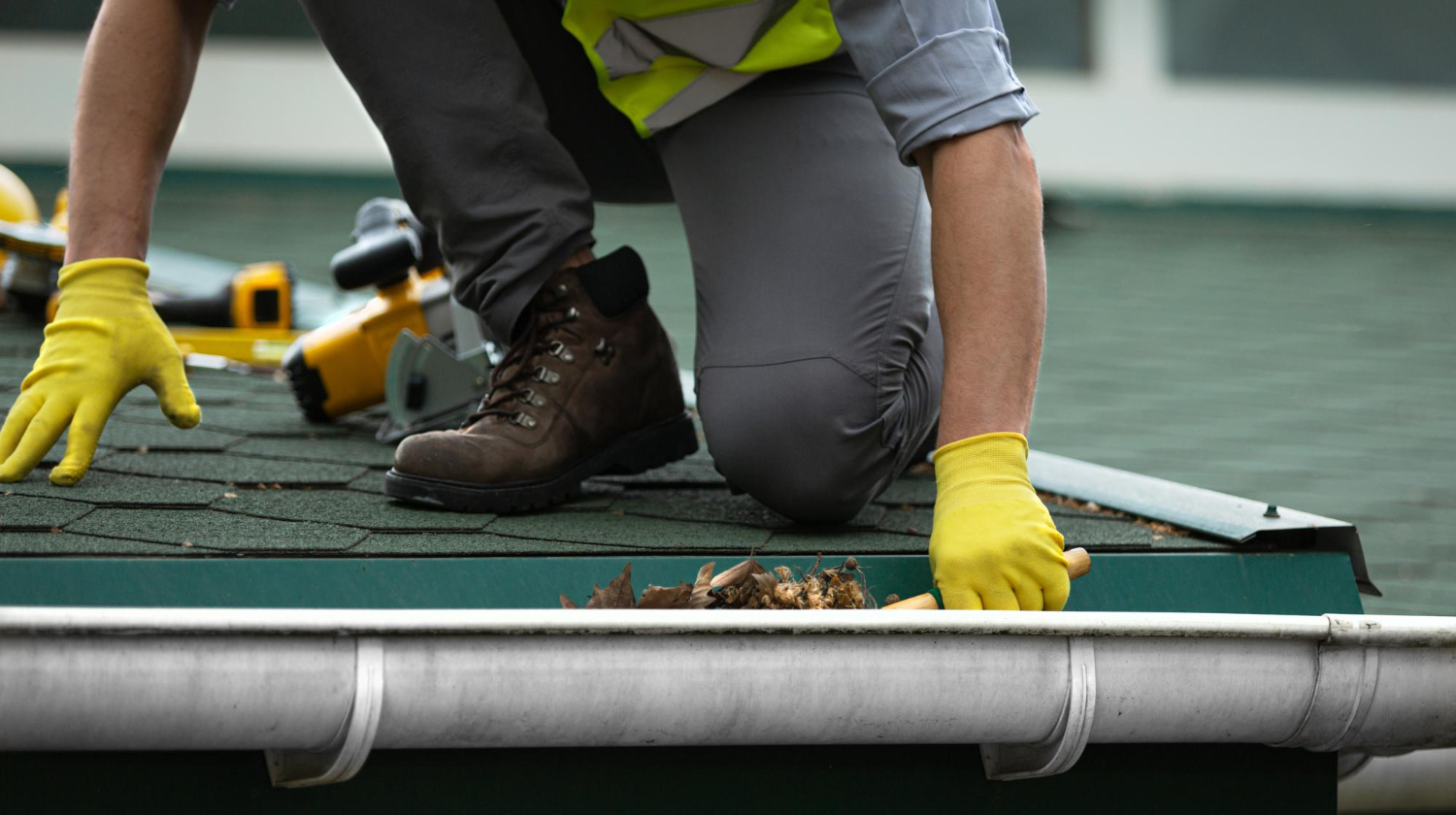Regular gutter cleaning prevents expensive water damage and keeps homes safe from foundation problems, roof leaks, and pest infestations.
Gutters protect homes by directing rainwater away from the foundation and exterior walls. When gutters become clogged with leaves, sticks, and debris, they can't do their job properly. This leads to water damage that costs homeowners thousands of dollars in repairs.
Many homeowners put off this important task because it seems difficult or dangerous. However, understanding the right methods and timing makes gutter maintenance much easier.
Homeowners have several options for keeping their gutters clean and functional. Whether someone chooses to clean gutters themselves or hire professionals depends on their comfort level, available time, and specific home needs.
In this article, you’ll learn how to approach gutter cleaning the right way, timing, tools, safety, and pro tips to prevent water damage.
Here’s what you need to know:
- Why gutter cleaning is essential for home protection
- How often should you clean your gutters?
- DIY vs. professional gutter cleaning services
- Gutter maintenance tips for lasting protection
Keep reading! The key is knowing when to clean, what tools to use, and how to maintain gutters for long-term protection.
Why gutter cleaning is essential for home protection
Clean gutters protect homes by directing water away from roofs, walls, and foundations. When gutters become clogged, water can cause expensive damage to multiple parts of a house and create health risks inside.
How clogged gutters cause costly roof and foundation issues
Blocked gutters force water to pool on roofs instead of flowing away from the house. This standing water can seep under shingles and cause rot in roof decking and support beams.
Water overflow from clogged gutters also creates problems around the foundation. When gutters can't direct water away, it spills over the sides and pools near the base of the house.
Foundation damage occurs when:
- Water saturates soil around the foundation
- Soil expansion puts pressure on foundation walls
- Freeze-thaw cycles create cracks in the foundation
- Water enters basement through foundation cracks
Roof repairs typically cost between $300 to $1,500 for minor damage. Foundation repairs can range from $2,000 to $15,000 depending on the extent of the damage.
Professional gutter repair services can identify early warning signs before major damage occurs. Regular cleaning prevents most of these costly issues from developing.
Why clean gutters prevent interior leaks and mold growth
Water that backs up in clogged gutters often finds its way inside homes through small gaps and cracks. This moisture creates the perfect conditions for mold and mildew growth.
Interior water damage typically starts in attics and crawl spaces where homeowners don't notice it right away. By the time visible signs appear, extensive damage may already exist.
Common areas affected by gutter-related leaks:
- Ceiling stains and water spots
- Wall discoloration and peeling paint
- Basement flooding and dampness
- Insulation damage in attics
Mold growth poses serious health risks for families. It can trigger allergies, asthma attacks, and other respiratory problems.
According to the U.S. Environmental Protection Agency (EPA), water-damaged areas should be dried within 24–48 hours to prevent mold growth, underscoring why fast cleanup after gutter-related leaks matters
Clean gutters channel water away from the house properly. This keeps moisture levels normal inside the home and prevents mold from taking hold.
The long-term savings of routine gutter maintenance
Regular gutter cleaning costs much less than repairing water damage. Most homeowners spend $150 to $300 per year on professional gutter cleaning services.
Compare this to major repair costs that result from neglected gutters. Water damage repairs often cost thousands of dollars and may not be fully covered by insurance.
Annual maintenance prevents:
- Roof replacement ($5,000-$15,000)
- Foundation repairs ($2,000-$15,000)
- Mold remediation ($500-$6,000)
- Interior water damage repairs ($1,000-$8,000)
Homes with well-maintained gutters also retain their value better. Potential buyers notice signs of water damage and often negotiate lower prices or walk away completely.
Gutter repair services recommend cleaning gutters at least twice per year. Homes with many trees may need cleaning three to four times annually.
How often should you clean your gutters?
Most homes need gutter cleaning twice per year, but the exact timing depends on your location, surrounding trees, and local weather patterns. The right schedule prevents water damage and keeps your drainage system working properly.
Seasonal timing for best results in the midwest
Midwest homeowners should clean gutters in late spring and early fall for optimal results. The spring cleaning removes winter debris like ice damage and early pollen buildup.
Fall cleaning is critical before winter weather arrives. Schedule this between mid-October and early November, after most leaves have fallen but before freezing temperatures begin.
Spring cleaning tasks:
- Remove accumulated winter debris
- Check for ice damage from freeze-thaw cycles
- Clear out seed pods and early spring growth
Fall cleaning priorities:
- Remove all fallen leaves and twigs
- Clear downspouts completely
- Inspect for loose connections before winter storms
Some Midwest homes need a third cleaning in mid-summer. This applies to properties with heavy tree coverage or those that experienced severe spring storms.
How tree coverage and weather affect cleaning frequency
Tree coverage dramatically changes how often gutters need attention. Homes surrounded by trees require cleaning three to four times yearly instead of the standard twice.
Different trees create different problems. Pine trees drop needles year-round, requiring more frequent maintenance. Oak and maple trees shed heavily in fall but stay cleaner in spring.
High-maintenance tree types:
- Pine, spruce, and evergreens (year-round debris)
- Oak trees (heavy acorn and leaf drop)
- Maple trees (helicopter seeds and large leaves)
Weather patterns also affect cleaning schedules. Heavy storm seasons mean more debris accumulation. Drought conditions can cause trees to drop leaves early, changing your typical fall cleaning timeline.
Homes with minimal tree coverage can often manage with twice-yearly cleaning. Properties in open areas or new developments typically need less maintenance than established neighborhoods with mature trees.
Signs that your gutters need immediate attention
Several warning signs indicate gutters need cleaning before your scheduled maintenance. Water overflow during rainstorms is the most obvious sign of blockage.
Sagging gutters suggest heavy debris buildup or standing water. This requires immediate attention to prevent structural damage to your roof or fascia boards.
Visible plant growth in gutters means debris has been sitting too long. Small plants and moss indicate poor drainage and accumulated organic matter.
Ice dams during winter signal blocked gutters that cannot drain properly. This creates serious roof damage risks and requires prompt professional attention.
According to the U.S. Department of Energy, ice dams at roof edges and gutters can force water to seep under shingles and leak into the house, so winter gutter maintenance is critical.
Staining on siding below gutters shows water has been spilling over edges instead of flowing through downspouts. This damages your home's exterior and foundation over time.
Check for these problems monthly during heavy debris seasons. Early detection prevents expensive repairs and water damage to your home's structure.
DIY vs. professional gutter cleaning services
Many homeowners face the choice between cleaning gutters themselves or hiring professionals. While DIY cleaning may save money upfront, it comes with serious safety risks and often incomplete results compared to professional services.
The hidden risks of DIY gutter cleaning
Ladder accidents cause thousands of injuries each year. Working on ladders while handling wet debris and cleaning tools creates multiple hazards.
Most homeowners lack proper safety equipment. Professional-grade ladders, harnesses, and stabilizers cost hundreds of dollars for occasional use.
Common DIY dangers include:
- Falls from unstable ladders
- Electrical shock from power lines
- Cuts from sharp metal edges
- Slips on wet surfaces
Hidden structural problems often go unnoticed during DIY cleaning. Loose gutters, damaged fascia boards, or foundation issues require trained eyes to spot early.
Incomplete cleaning is another major issue. Homeowners typically miss downspout blockages or small debris that professionals would catch.
What a professional gutter service includes
Professional gutter cleaning goes far beyond removing leaves and debris. Trained technicians bring specialized tools and systematic approaches.
Standard professional services include:
- Complete debris removal from gutters and downspouts
- Flushing systems with water to test flow
- Checking for leaks, rust, or damage
- Inspecting mounting hardware and slope
- Minor repairs when needed
Most companies also clean up the surrounding area. They bag all debris and check for any property damage from the cleaning process.
Professional equipment makes the job safer and more thorough. Industrial vacuums, pressure washers, and telescoping tools reach areas homeowners cannot access safely.
Many services include written reports of gutter condition. These help homeowners plan future maintenance and spot problems early.
Why hiring experts saves time, stress, and potential injury
Professional gutter cleaning typically takes 1-2 hours compared to a full day for most homeowners. Experts work efficiently with proper tools and experience.
The stress of working at heights disappears when hiring professionals. Licensed and insured technicians handle all safety concerns and liability issues.
Key benefits of professional service:
- Guaranteed thorough cleaning
- Insurance coverage for accidents
- Expert problem identification
- No equipment purchases needed
- Regular maintenance scheduling
Professional gutter cleaning costs between $100-300 for most homes. This investment protects against expensive water damage that poor maintenance can cause.
Many companies offer seasonal packages or annual contracts. These agreements ensure regular maintenance without homeowners remembering to schedule appointments.
Gutter maintenance tips for lasting protection
Proper gutter care requires attention to downspouts, protective upgrades, and early damage detection. These key areas prevent costly water damage and extend your gutter system's life.
How downspout cleaning prevents basement flooding
Downspout cleaning plays a critical role in directing water away from your home's foundation. When downspouts get clogged with leaves, dirt, or debris, water backs up and overflows near the foundation walls.
This overflow creates serious problems. Water pools around the basement walls and seeps through cracks or weak spots. Even small amounts of water can cause major flooding over time.
Signs your downspouts need cleaning:
- Water spilling over gutter edges during rain
- Puddles forming near the foundation
- Stains or mineral deposits on downspout exteriors
- Gurgling sounds when water flows through
Regular downspout maintenance involves flushing them with a garden hose from the top. If water doesn't flow freely, use a plumber's snake or pressure washer to remove stubborn clogs.
Check that downspouts extend at least 6 feet from your foundation. This distance ensures water flows away from the house instead of pooling near basement walls.
When to consider gutter guards or upgrades
Gutter guards reduce maintenance needs and prevent frequent clogging. They work best for homes surrounded by many trees or in areas with heavy leaf fall.
Good candidates for gutter guards include:
- Multi-story homes that are hard to clean
- Properties with lots of pine needles or small debris
- Homeowners who travel frequently
- Older adults who want to avoid ladder work
Different guard types serve different needs. Mesh screens block most leaves but may trap small debris. Solid covers with slots work well but cost more to install.
Consider upgrades when your current gutters show wear. Signs you need new gutters:
- Rust spots or holes
- Separated joints
- Sagging sections
- Frequent overflow problems
Upgrading to larger gutters helps homes in heavy rain areas. Six-inch gutters handle more water than standard five-inch ones.
How to spot early signs of gutter damage or sagging
Early damage detection saves money and prevents bigger problems. Most gutter issues start small but grow worse without attention.
Visual warning signs include:
- Gutters pulling away from the house
- Visible rust, cracks, or holes
- Paint peeling on siding near gutters
- Water marks or stains below gutter lines
Sagging occurs when gutters hold too much weight from debris or standing water. Check for sections that look lower than others or have gaps at the joints.
Test gutter stability by gently pushing up on different sections. Properly mounted gutters should feel solid and not move much. Loose or wobbly areas need immediate repair.
Look for fascia board damage behind the gutters. Soft, rotting, or discolored wood means water has been getting behind the gutter system. This problem requires quick action to prevent structural damage.
Check after every major storm for new damage. High winds and heavy rain can shift gutters or create new problems that weren't there before.
Conclusion
Gutter cleaning stands as a vital part of home care that protects property and saves money. Clean gutters direct water away from roofs and foundations properly.
Regular maintenance prevents costly repairs that can reach thousands of dollars. Clogged gutters cause water to overflow and damage siding, roofs, and foundations.
Homeowners should clean gutters at least twice per year. Fall and spring cleanings work best for most homes. Areas with many trees may need more frequent cleaning.
Professional cleaning offers advantages like specialized equipment and safety expertise. However, homeowners can handle basic cleaning with proper tools and care.
Clean gutters maintain home value and prevent serious structural issues. The small investment in regular cleaning pays off through avoided damage and repairs.
Gutters that work properly channel rainwater and melted snow away from the home. This simple system protects one of the largest investments most people make.
Taking action on gutter maintenance before problems start saves time and money. Clean gutters mean a protected home and peace of mind for property owners.
Schedule professional gutter cleaning with Michaelis today to prevent water damage and keep your roof, walls, and foundation protected.




.avif)

